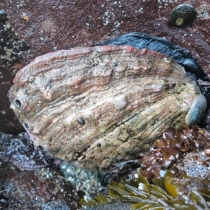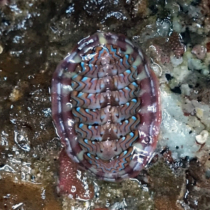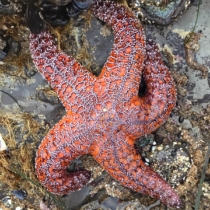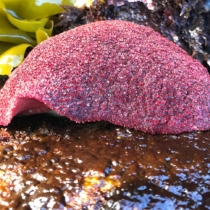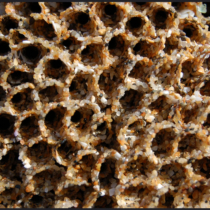Our updated adaptive sampling methods used from August 2019 to the present can be found here
Our main objective for monitoring the sandy beach is to establish baseline information about the abundance and distribution of the Pacific mole crab. By monitoring, we can track changes (or lack of changes) in abundance over time. The sampling methods are described below.
Setting Up the Sample Area:
A 50-m line is placed above the swash zone, parallel to shore. This line should be placed in an area where there are signs of sand crabs (molts, shorebirds, ripples or holes in the wet sand). Each group of students will choose a random number between 0 and 50 and they will find their random number on the 50-m line. Next, students will systematically search for a patch of sand crabs near their random number. They will do this by digging into the sand with their hands. If the students are digging in relatively dry sand, and not finding sand crabs, they should move 1-m closer to the water and dig again. If they are digging in relatively wet sand and not finding any sand crabs, they should move to the left or right 1-m and dig again. They should continue searching for sand crabs systematically until they find one crab. When they find their first crab, they should mark that spot as the top of their vertical transect. Then, they will measure from the top of their vertical transect into ankle deep water. This will give them their vertical transect length. Each group will calculate the spacing between sample points: vertical transect length ➗ 9 = distance between sample points. Students will be using pacing steps to measure the distance between sample points, so each student should practice what a 1-m step feels like.
Collecting Samples:
Starting at the top of the vertical transect (the spot where they found their first crab) students will begin taking their 10 samples. One student, the corer, will press the core (10 cm diameter) into the sand approximately 10 cm while another student holds the first mesh bag to receive the sand. Then the corer will use their pacing step to move to the next sample point, and take the next core into the second mesh bag. Meanwhile, the other students should be bringing the next mesh bags down to the corer in order, and they should be bringing the full bags up to the dry sand. Once all 10 samples are collected, students can begin sifting through the bags by dunking them into a bucket of water one at a time.
Recording Data:
If mole crabs are present in a sample, determine the size and sex of each crab. Determine the size by measuring the length of the carapace with a caliper (to the nearest millimeter). Determine sex by carefully lifting the telson. Females are identified by the presence of modified legs, or pleopods, under the telson. Ovigerous females are identified by an orange or brown mass of eggs. Males lack both pleopods and eggs. sex cannot be determined if crabs are 9 mm or msmaller. These tiny crabs are considered “recruits.” Record data on data sheets and return animals to the swash zone.
Parasite Analysis:
In this optional extension to sandy beach monitoring, the presence of a parasitic worm (Phlyum: Acanthocephala) is investigated. A fishing permit or scientific collecting permit is needed to conduct this activity. About 30 crabs should be collected and placed in a zip lock bag. Place the ziplock bag in a freezer for more than 4 hours. Thaw and dissect crabs. Count the number of parasites present in the midgut of each crab.








